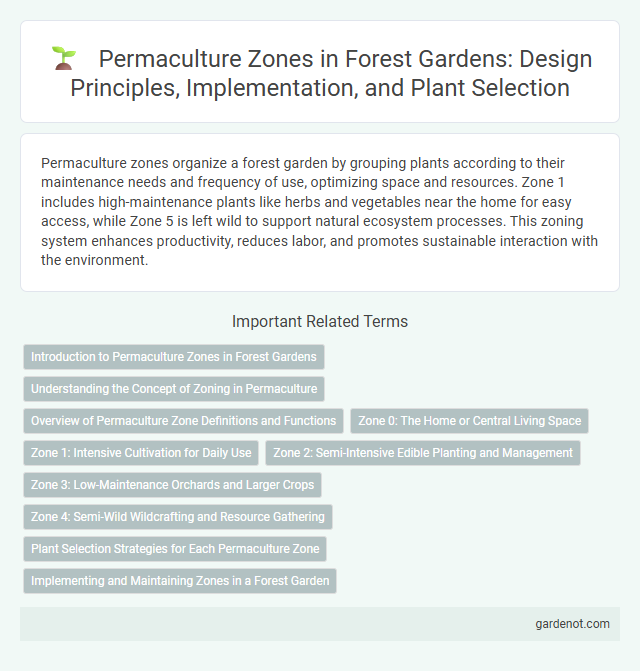Permaculture zones organize a forest garden by grouping plants according to their maintenance needs and frequency of use, optimizing space and resources. Zone 1 includes high-maintenance plants like herbs and vegetables near the home for easy access, while Zone 5 is left wild to support natural ecosystem processes. This zoning system enhances productivity, reduces labor, and promotes sustainable interaction with the environment.
Introduction to Permaculture Zones in Forest Gardens
Permaculture zones in forest gardens organize spaces based on frequency of use and plant needs, optimizing energy and resource efficiency. Zone 1 includes high-maintenance plants and herbs near living areas for frequent harvesting, while Zone 5 remains a natural, undisturbed ecosystem promoting biodiversity. Proper zoning enhances sustainability, productivity, and harmony within forest garden design.
Understanding the Concept of Zoning in Permaculture
Permaculture zones organize a forest garden into functional areas based on frequency of use and maintenance needs, ranging from Zone 0 at the home to Zone 5, the unmanaged wild area. This zoning system maximizes energy efficiency by placing key elements like herbs and vegetables close to the home, while less intensive zones house larger trees and natural ecosystems. Understanding permaculture zoning enhances sustainable land management, improves resource allocation, and supports biodiversity within the forest garden design.
Overview of Permaculture Zone Definitions and Functions
Permaculture zones categorize garden spaces based on frequency of use and plant care needs, ranging from Zone 0 at the home to Zone 5 natural wilderness. Zone 1 is closest to the house for daily tasks and intensive cultivation, while Zone 2 supports perennial plants and small animals with less frequent visits. Zone 3 includes larger crops requiring occasional maintenance, and Zones 4 and 5 are semi-wild or wild areas encouraging biodiversity and ecological sustainability.
Zone 0: The Home or Central Living Space
Zone 0 in permaculture design refers to the home or central living space, serving as the heart of the forest garden system. It integrates sustainable features such as passive solar heating, rainwater harvesting, and natural ventilation to minimize environmental impact. Efficient design in Zone 0 enhances energy conservation and fosters a seamless connection between indoor living and the surrounding forest garden ecosystem.
Zone 1: Intensive Cultivation for Daily Use
Zone 1 in permaculture design is dedicated to intensive cultivation of plants and herbs used daily, maximizing accessibility and productivity near the home. This zone typically includes vegetable beds, culinary herbs, salad greens, and small fruit plants, arranged to reduce labor and water usage. Strategic placement in Zone 1 ensures efficient harvesting while promoting sustainable growth and biodiversity within the forest garden ecosystem.
Zone 2: Semi-Intensive Edible Planting and Management
Zone 2 in a forest garden emphasizes semi-intensive edible planting and management, focusing on perennial vegetables, herbs, and small fruit shrubs that require moderate maintenance. This area balances productivity and effort by integrating species such as asparagus, rhubarb, and berry bushes, which benefit from regular but less frequent care compared to Zone 1. Strategic placement of Zone 2 crops optimizes space and resources, enhancing biodiversity while ensuring sustainable food production.
Zone 3: Low-Maintenance Orchards and Larger Crops
Permaculture Zone 3 is designed for low-maintenance orchards and larger crops that require less frequent attention than intensive garden beds. This zone typically includes fruit and nut trees, berry bushes, and staple crops like corn or squash, positioned to maximize space and sunlight while conserving water. Effective management in Zone 3 enhances productivity with minimal labor, supporting sustainable forest garden ecosystems.
Zone 4: Semi-Wild Wildcrafting and Resource Gathering
Zone 4 in permaculture, known as the semi-wild or wildcrafting zone, serves as a transitional space between intensive cultivation and the natural wilderness. It supports resource gathering such as timber, firewood, medicinal plants, and wild edibles, emphasizing sustainability and minimal intervention. Efficient management of this zone enhances biodiversity while providing essential materials for the forest garden ecosystem.
Plant Selection Strategies for Each Permaculture Zone
Permaculture zones range from Zone 0 (home) to Zone 5 (wilderness), each requiring specific plant selection to maximize efficiency and sustainability. In Zone 1, prioritize herbs, vegetables, and perennials that need frequent attention and provide quick yields, while Zone 2 suits orchard trees and larger shrubs that require less maintenance but deliver abundant harvests. Zone 3 supports larger, low-maintenance food crops like nut trees and staple grains, whereas Zone 4 focuses on timber, forage, and wild edibles, and Zone 5 remains natural to encourage biodiversity and ecosystem stability.
Implementing and Maintaining Zones in a Forest Garden
Permaculture zones in a forest garden optimize resource efficiency by organizing plants and activities based on their frequency of use and maintenance needs. Zone 1, closest to the gardener's home, typically includes herbs, salad greens, and frequently harvested vegetables, while Zone 3 contains larger trees and perennial crops requiring less frequent attention. Implementing and maintaining these zones enhances productivity, conserves energy, and supports biodiversity through strategic plant placement and regular observation.
Permaculture zone Infographic

 gardenot.com
gardenot.com